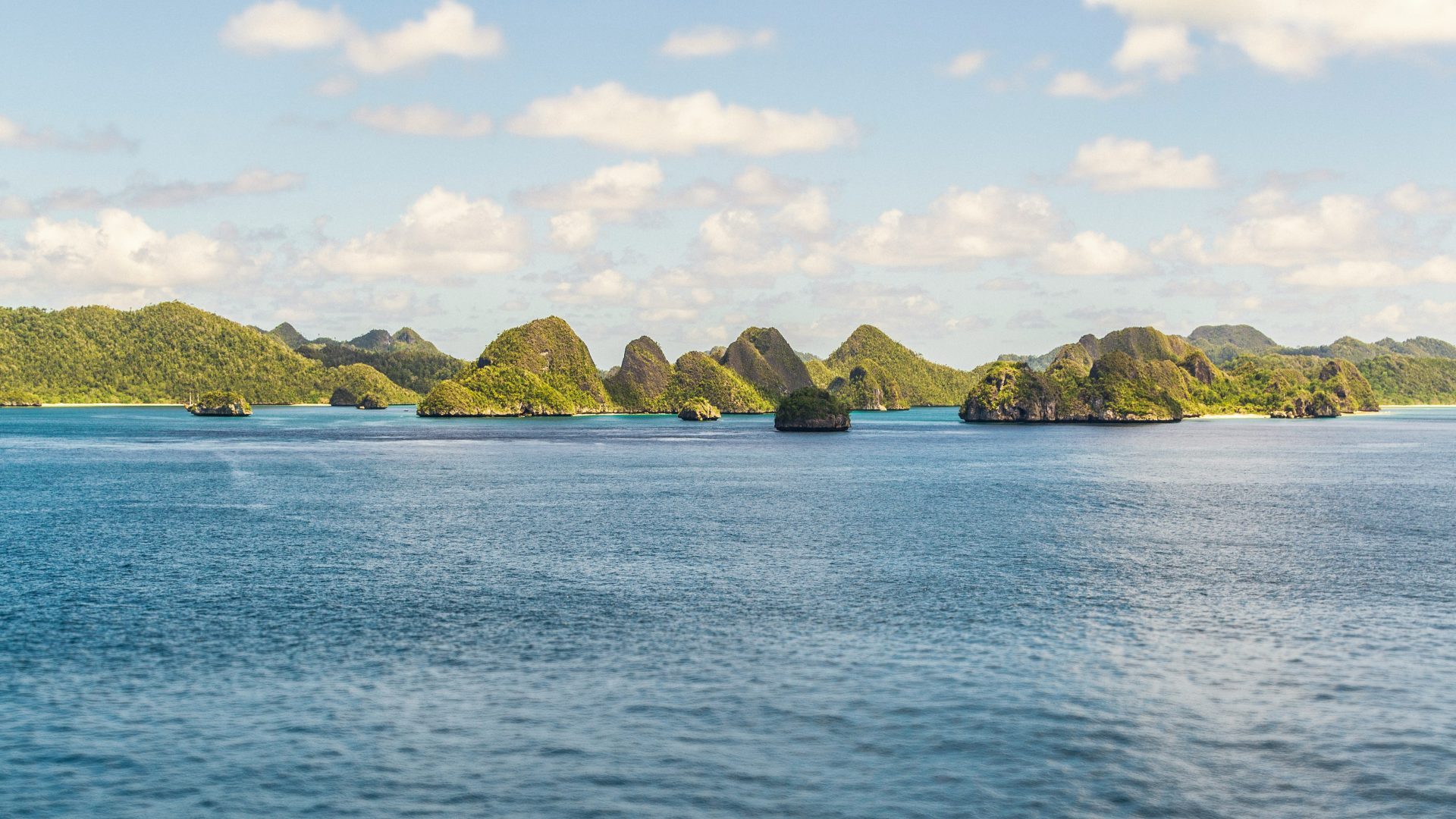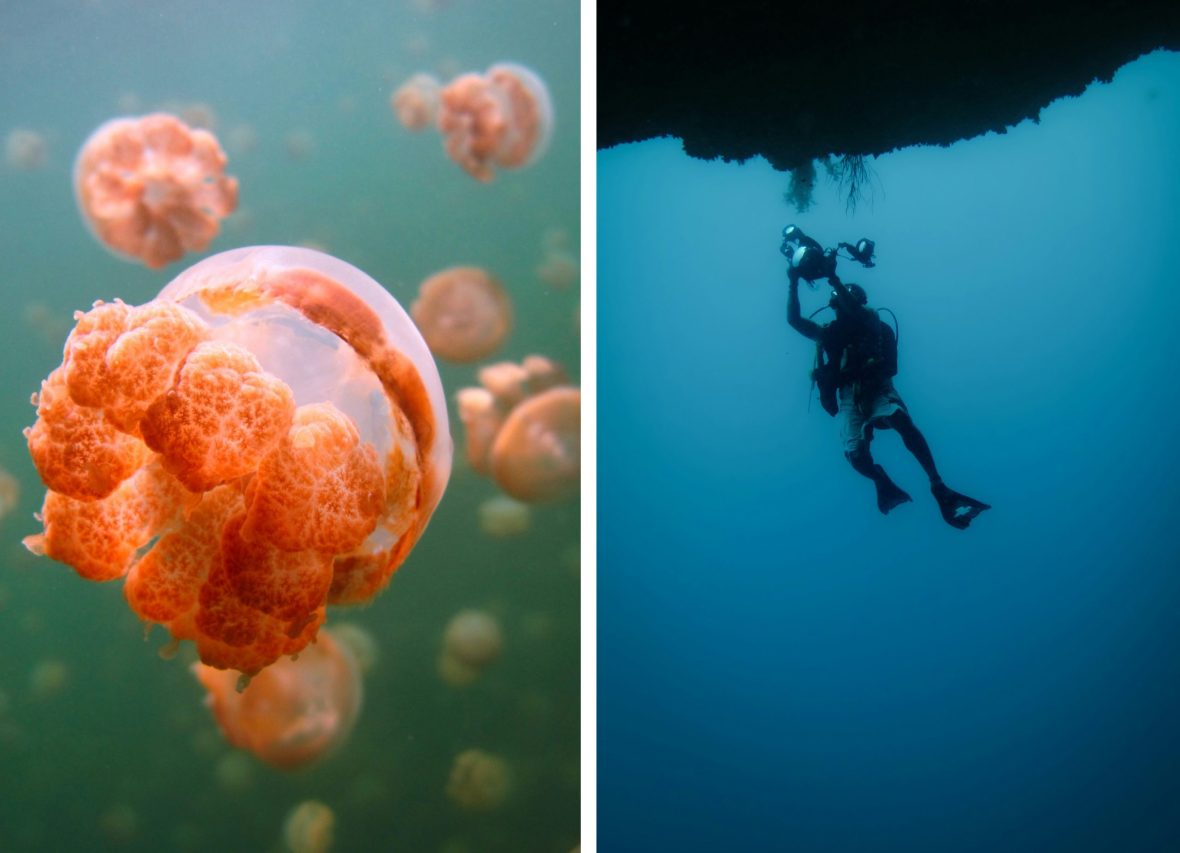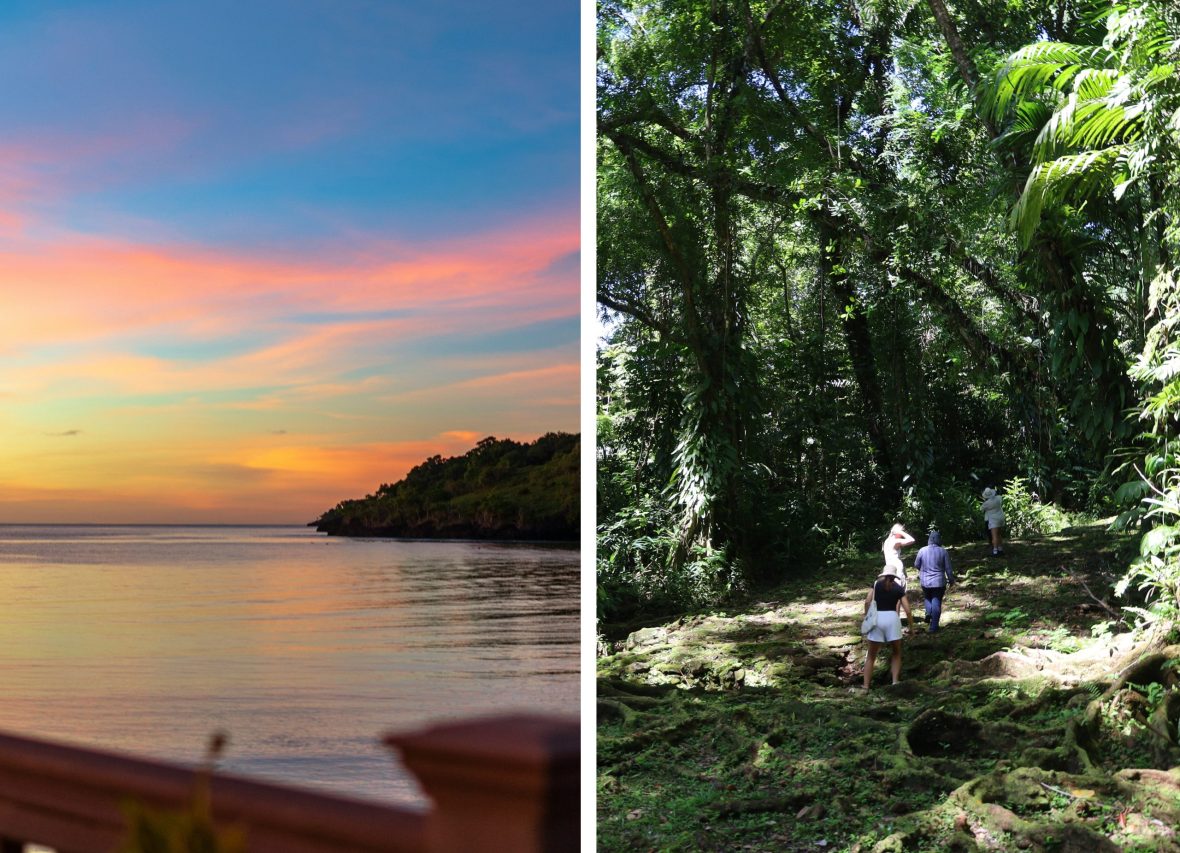
If you’re a history buff or conservationist, you might be familiar with Palau. If you’re a diver, you definitely are—and for good reason. We sent writer Lizzie Mulherin to the Pacific nation; she came back with the ultimate island guide.

If you’re a history buff or conservationist, you might be familiar with Palau. If you’re a diver, you definitely are—and for good reason. We sent writer Lizzie Mulherin to the Pacific nation; she came back with the ultimate island guide.
With just over 18,000 inhabitants, Palau—also traditionally known as Belau—is one of the smallest countries in the world by population size. But don’t let the ‘lack’ of people per capita fool you; this republic is brimming with a unique mix of ancient native sites, WWII remnants, world-renowned reefs, lush tropical terrain and gimmick-free cultural activities that appeal to pretty much every travel niche.
And I can vouch for all that—I’m just back from exploring the island myself. Scenically, it’s all pastel-blue lagoons, blindingly white beaches and green forests to rival Borneo and the Maldives. But unlike many tropical destinations, Palau hasn’t fallen victim to overtourism—and the country plans to keep it that way.
If you—like me—want to protect the places you visit and never compete for sea views, then Palau is worth adding to your itinerary. Here’s everything you need to know before you go.
Palau is an archipelago peeking out of the western Pacific Ocean between the Philippines, Papua New Guinea and Guam. With over 300 coral and volcanic islands, it’s marked by an extensive barrier reef system and the UNESCO World Heritage-listed Rock Islands Southern Lagoon—home to hundreds of limestone masses blanketed in emerald forests, ancient rock villages and at least 13 species of shark (but don’t let that put you off—there are dugongs and manta rays too).
Good question. Long answer. As one of the Seven Underwater Wonders of the World, the archipelago consistently tops traveler’s ‘must-dive’ lists—and honestly, you shouldn’t miss the diving, the biodiversity is extraordinary—but Palau’s draw cards are both above and below its surface.
Estimates say Palau was first inhabited between 2,000 and 3,000 years ago by successive groups of sea voyagers from Indonesia and Southeast Asia.
On land, you can: Learn the art of wood carving on locally sourced mahogany from a traditional master; walk an ancient stone pathway leading to a traditional sun dial on Airai island; see Palau’s oldest remaining Bai (temple hut); and discover fallen WWII relics and hidden war tunnels that are now being reclaimed by nature. Food and cultural heritage experiences thrive here: Learn traditional cooking and weaving skills with local aunties; try Palauan delicacies, like tapioca and coconut cream dessert; and watch traditional dancing at the 680 Night Market in Koror, Palau’s largest city.
At sea, a whole other adventure universe awaits. I spent my time: Swimming Palau’s pastel natural spa, the ‘Milky Way’; snorkeling with reef sharks off Ngermaus Island; sailing in a traditional Palauan canoe—made using local timber, coconut husk rope and tree sap glue; kayaking the pristine Nikko Bay, paddling through hidden caves and eating lunch on a private beach; and looking for lost jellyfish in Jellyfish Lake.

Respect for nature is inherent in Palauan culture, and sustainability is a huge priority. Upon entry, all visitors must sign the Palau Pledge; a code of conduct that commits travelers to act in an “ecologically and culturally responsible way on the island, for the sake of Palau’s children and future generations”.
This is because Palau is one of the world’s countries most feeling the effects of climate change. Amidst rising sea levels, Palau’s most unique tourist attraction—Jellyfish Lake, home to thousands of non-stinging jellyfish—is now largely empty thanks to rising water temperatures.
Preventing overtourism is also a major mission here. An upsurge in visitors in pre-Covid-19 years saw 100,000 tourists visiting the tiny nation annually, which was deemed too many for both its infrastructure and environment. While tourism is important for the economy, the national government is also very conscious of preserving Palau’s pristine sites.
Estimates say Palau was first inhabited between 2,000 and 3,000 years ago by successive groups of sea voyagers from Indonesia and Southeast Asia. The Spanish were the first Europeans to claim ownership of Palau in 1885, which was then sold to Germany in 1898 who occupied the archipelago until 1914 when the Japanese claimed territory.
In 1944, WWII conflict destroyed much of Palau’s land and native sites, and the region was claimed for a fourth time in recent history by America. Some 50 years later Palau voted to become an independent nation—though the US is still heavily involved in its defense, infrastructure and education systems. In fact, Palau’s currency today is still the US dollar.
Today Palauan culture is a multifaceted mix. For example, in the economic capital of Koror, many modern restaurants are Japanese-fusion, and English is the dominant language, but traditional Palauan culture is fiercely protected. And Malayo-Polynesian language is still spoken across much of the republic.
A number of historic customs and ceremonies are still upheld, including: Long-standing weaving and wood-carving practices; canoe-building using only traditional materials; a week-long cleansing ritual for new mothers; women passing down money stone necklaces between generations; and regular Council of Chiefs meeting inside a Bai—a traditional men’s meeting house etched with vibrant paintings that tell ancient clan stories.
Yes. Despite being occupied by Western countries for over 100 years, Palau has maintained many of its matrilineal practices; family lineage, property rights and inheritance are often traced through the mother’s side.
Day-to-day operations in Palauan villages, or clans, are governed by a Council of Chiefs—who are mostly men, but chosen and anointed by a council of women; the matriarchs. Matriarchs also oversee village finances and land; any proposals for clan property rights must be approved by them. Palau has a US-style democratic government, but the Council of Chiefs advise the president on anything to do with traditional custom or law.
Because of Palau’s history, the food scene is more diverse than you’d expect. The historic national dish features a whole fruit bat — wings, teeth, fur and all — served in a broth with local spices.
Palau has a tropical climate; heat and humidity are generally constant with average temperatures ranging from roughly 25°C (77°F) to 31°C (88°F) year-round. Rainfall tends to be higher during monsoon season, between June-October.
This means Palau’s dry season—between December and April—is arguably the best time of year to visit. Just be sure to pack enough cool, loose-fitting, sun-safe clothing. As for local customs, it’s respectful not to wear swimsuits or very short pieces of clothing in villages or public places. It’s also respectful to bring reef-safe sunscreen with you. Diving equipment can be hired at most tour operators, and if you plan to spend a lot of time underwater, a GoPro won’t go astray.

Because of Palau’s history, the food scene is more diverse than you’d expect. The historic national dish features a whole fruit bat—wings, teeth, fur and all—served in a broth with local spices. Once a staple due to the lack of readily available protein on land, it’s now reserved for mostly elder Palauans and curious, brave visitors (I gave it a go, it was, erm, interesting). Available at Carp Restaurant and Drop Off Bar & Grill.
You can’t skip oshiruko. The Japanese-inspired dessert features warm mochi balls served in sweet red bean soup, and it’s delicious. Wash it down with a fresh coconut at the 680 Night Market. In the same vein is local dish; tapioca and coconut cream. Tapioca is a locally grown starch, and makes for a filling treat, especially with fresh coconut cream. You can buy it in local supermarkets or make it yourself on the Airai Cultural Heritage Tour.
Is both your stomach appetite and your adventure appetite now whetted? Understandable. If you want to see what conscious preservation can do for a country and experience one of the world’s last matriarchies—and try fruit bat soup—you won’t be disappointed by Palau.
Read more
Flights with the ‘Palau Paradise Express’ will fly direct from Brisbane to Koror in six hours. The writer was hosted by Palau Visitors Authority.
***
Adventure.com strives to be a low-emissions travel publication. We are powered by, but editorially independent of, Intrepid Travel, the world’s largest travel B Corp, who help ensure Adventure.com maintains high standards of sustainability in our work and activities. You can visit our sustainability page or read our Contributor Impact Guidelines for more information.
Lizzie Mulherin is a freelance travel writer, guidebook author and self-diagnosed heliophile with an inconvenient (albeit impressive) knack for getting lost—even while under strict supervision. Her work has been published in Time Out, Huffington Post, Mamamia, Marie Claire and more. Having called six cities in four countries home over the last 10 years, sitting still is not her strong suit.






Can't find what you're looking for? Try using these tags: